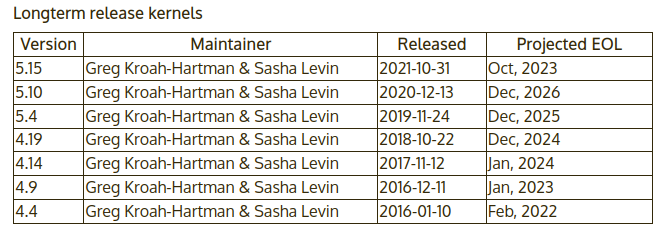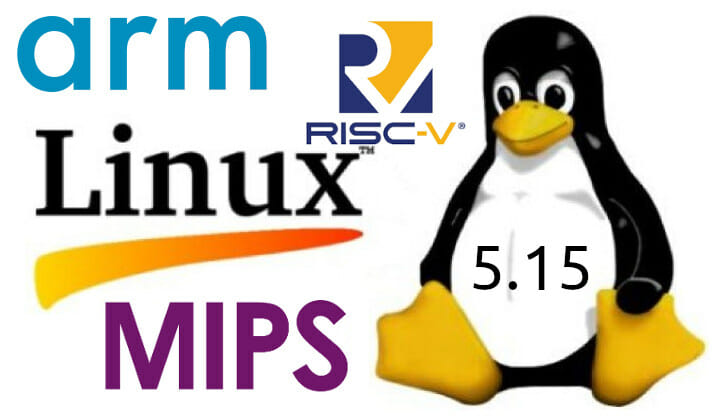Linus Torvalds released Linux 5.15, an LTS version, this past Sunday:
It’s been calm, and I have no excuse to add an extra rc, so here we are, with v5.15 pushed out, and the merge window starting tomorrow.
Which is going to be a bit inconvenient for me, since I also have some conference travel coming up. But it’s only a couple of days and I’ll have my laptop with me. Sometimes the release timing works out, and sometimes it doesn’t..
Anyway, the last week of 5.15 was mainly networking and gpu fixes, with some random sprinkling of other things (a few btrfs reverts, some kvm updates, minor other fixes here and there – a few architecture fixes, couple of tracing, small driver fixes etc). Full shortlog appended.
This release may have started out with some -Werror pain, but it calmed down fairly quickly and on the whole 5.15 was fair small and calm. Let’s hope for more of the same – without Werror issues this time – for the upcoming merge window.
Linus
Released around two months ago, Linux 5.14 added support for Raspberry Pi 400 keyboard computer, merged the core scheduling functionality, removed the old IDE block drivers, improved support for Intel Alder Lake processors, and more.
Linux 5.15 will be an LTS kernel getting long-term support for at least 2 years, and possibly more, if companies extensively use the new kernel and request a longer support period up to 6 years like for Linux 5.10 or Linux 5.4 for instance.
 Some of the notable changes for Linux 5.15 include:
Some of the notable changes for Linux 5.15 include:
- New NTFS file system implementation distributed by Paragon Software with read/write support, that removes the need to use the userspace ntfs-3g implementation for write support. The current implementation supports NTFS file system versions up to 3.1, normal/compressed/sparse files, and journal replaying, with more features coming in the future.
- ksmbd in-kernel SMB 3 server that should deliver optimized performance and better lease handling (distributed caching). It’s NOT meant to fully replace Samba which has a more extensive set of features and tools.
- DAMON (Data Access MONitor) is a lightweight mechanism to monitor the memory access pattern of specific user-space processes. It can tell you which parts of the memory of a process are being accessed all the time, and which ones are not being used. It can be used with damo user-space tool to check your program’s memory behavior. See LWN article for additional information.
- Real-time preemption locking code has been merged – When PREEMPT_RT is enabled, mutex, ww_mutex, rw_semaphore, spinlock and rwlock primitives are now substituted by RT-Mutex based variants. See merge log for details.
Arm architecture updates in Linux 5.15
- Allwinner
- A83t USB OHCI/EHCI documented
- Rockchip
- PCIe – Rockchip DesignWare PCIe controller driver for RK356X host controller
- Pinctrl – major refactoring of the Rockchip driver, breaking part of it out
to a separate GPIO driver in drivers/gpio - Rockchip i/o domain support
- Handro driver
- Gained support for H.264 for Rockchip VDPU2 decoder
- Added support for Rockchip PX30
- ASoC – Rockchip RK3568 S/PDIF support
- gpu mali-bifrost – Add RK3568 compatible string for RK3568’s Bifrost Mali-G52 GPU
- Amlogic
- Added driver for Amlogic Meson IR transmitter (aka IR blaster)
- PHY driver – Updates for Amlogic Meson8b-usb2 phy
- ARM device tree changes:
- meson8: use a default higher default GPU clock to solve probe failure
- meson: add AIU audio controller and codec for ec100
- meson8b: fix PWM regulator supply property name
- Linux 5.15 ARM64 device tree changes:
- nanoki-k2: enable bluetooth
- Kkhadas VIM & VIM2: improve wifi
- add audio to nodes vega-s95, nexbox-a1
- ARM config changes – Enable CONFIG_MMC_MESON_MX_SDHC controller used on meson8/8b
- Samsung
- Pinctrl – Support for Samsung Exynos850 SoC (Exynos3830), minor fix
- PHY – Updates for Amlogic Meson8b-usb2 phy, Samsung ufs phy
- DTS ARM changes for Linux 5.15 – Add CPU topology and cache information to Exynos DTSI files.
- DTS ARM64 changes
- Add CPU topology and cache information to Exynos DTSI files.
- Correct GIC CPU interfaces address range on Exynos7.
- Qualcomm
- Added support for Qualcomm Snapdragon SDM636 and SM8150
- Pinctrl
- New subdriver for Qualcomm MDM9607 and SM6115
- Support for Qualcomm PMC8180, PMC8180C, SA8155p-adp PMIC GPIO
- PHY
- UFS PHY for Qualcomm SM6115
- PCIe & USB/DP PHY for Qualcomm sc8180x
- USB3 PHY support for Qualcomm IPQ6018
- IPQ6018 gains USB2 and PCIe
- IPQ8074 gains SCM, PRNG and Crypto support
- SC7180 – DisplayPort support
- ARM64 defconfig update – enabled the MSM8996 CPU clock driver, enabling CPUfreq on the platform.
- DTS updates for Linux 5.15
- MSM8974 gains another UART for Bluetooth (on the Sony Xperia Z2 Tablet)
- Samsung Galaxy S5 gains regulator definitions for audio and modem remoteprocs
- DSI clocks on APQ8064 are updated as the old legacy clock names are no longer supported by the driver
- IPQ806x GMAC nodes gains AHB resets wired up.
- APQ8060 is converted to a SPDX header and the ethernet node is updated in accordance with the binding.
- New devices & boards
- Snapdragon 665 based Sony Xperia 10II
- Snapdragon MSM8916 based Xiaomi Redmi 2
- Snapdragon MSM8226 based Samsung Galaxy S3 Neo
- MediaTek
- Power management – New cpufreq driver for the MediaTek MT6779 platform called
mediatek-hw along with corresponding DT bindings - PCIe controller driver – Add MT7629 support in DT
- Power management – New cpufreq driver for the MediaTek MT6779 platform called
- Other new Arm hardware platforms and SoCs
- ASpeed – AST2600 BMC implementations for Facebook Cloudripper, Elbert and Fuji server boards.
- Marvell – CN913x reference boards
- Microchip – New SAMA7 Cortex-A7 SoC family based on the older SAMA5 series, with the first part being SAMA7G5.
- NXP
- i.MX 6 – DHCOM PicoITX, DHSOM DRC0, SolidRun SolidSense, SKOV i.MX6 boards.
- i.MX 8/8M – Nitrogen8 SoM and MNT Reform2, LS1088A based Traverse Ten64, Gateworks Venice GW7902 SBC.
- NVIDIA – Jetson TX2 NX Developer Kit
- Renesas – R-Car H3e-2G and M3e-2G SoCs
- ST-Ericsson – ux500 based Samsung phones: Gavini, Codina, and Kyle
- STMicro – 4KOpen STiH418-b2264 development board
- Texas Instruments – AM335x based Sancloud BBE Lite
RISC-V Linux 5.15 changelog
RISC-V updates listed in Linux 5.15:
- Support PC-relative instructions (auipc and branches) in kprobes
- Support for forced IRQ threading
- Support for the hlt/nohlt kernel command line options, via the generic idle loop
- Show the edge/level triggered behavior of interrupts in /proc/interrupts
- Handful of cleanups to our address mapping mechanisms
- Support for allocating gigantic hugepages via CMA, hugepage migration
- Support for the undefined behavior sanitizer (UBSAN)
- Handful of cleanups to the VDSO that allow the kernel to build with LLD.
- A pair of defconfig additions for NVMe and the EFI filesystem localization options.
- A larger address space for stack randomization.
- A cleanup to our install rules.
- A DTS update for the Microchip Icicle board to fix the serial console.
A couple of MIPS updates
Unsurprisingly, MIPS development work has almost come to a halt in Linux 5.15 with very minor changes:
- Converted Pistachio platform to use MIPS generic kernel
- Fixes and cleanups
There used to be some work by Loongson in recent releases, but they seem to have switched the focus on LoongArch instead of MIPS per se:
We are preparing to add new Loongson (based on LoongArch, not MIPS) support. LoongArch use ACPI other than DT as its boot protocol, so add its support for ACPI_PROCESSOR/ACPI_NUMA.
For more details, you can read the full Linux 5.15 changelog with comments only, generated with the command git log v5.14..v5.15 --stat, or alternatively, read the in-depth Linux 5.15 changelog on KernelNewbies website.

Jean-Luc started CNX Software in 2010 as a part-time endeavor, before quitting his job as a software engineering manager, and starting to write daily news, and reviews full time later in 2011.
Support CNX Software! Donate via cryptocurrencies, become a Patron on Patreon, or purchase goods on Amazon or Aliexpress





